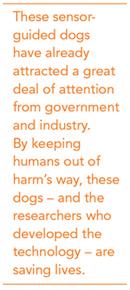Man's Best Friend Goes it Alone
|
||||||||
 |
| Auburn's Canine
Detection Research
Institute turned to
the college for help
with instrumentation
and materials in discovering new ways for dogs to detect hazardous substances. |
While people most often see dogs as pets, we all know that they can be used in many other areas of our daily lives. They can be trained to guide someone with impaired vision or to guard a family's safety; they can search for drugs, bombs or even missing people after a disaster. But until now, they have always needed a master or human trainer to accompany them into situations that could quickly turn perilous. Enter the first autonomously controlled dog.
Using a computer and a sensoractivated vest recently developed at Auburn, canines can now be autonomously guided using various tones and vibrations. This collaborative project between the departments of Mechanical Engineering and Computer Science and Software Engineering, as well as the Auburn University College of Veterinary Medicine, is led by engineering doctoral student Winard "Win" Britt.
These sensor-guided dogs have already attracted a great deal of attention from government and industry. By keeping humans out of harms way, these dogs and the researchers who developed the technology are saving lives.
 Dave Bevly, faculty member in
mechanical engineering, had
applied for a grant from the
Office of Naval Research (ONR)
Young Investigator Program. He submitted
several possible topics, mostly focusing
on the work he was already doing with
guided autonomous vehicles in Auburn
engineering's GPS and
vehicle dynamics lab
(GAVLAB), which includes
control and navigation
of vehicles using GPS in
conjunction with other
sensors, such as Inertial
Navigation System (INS)
sensors. The lab has
several research thrusts,
including sensor fusion and
integration, online system
identification, adaptive and
robust control algorithms
and vehicle state and
parameter estimation. The
work is focused toward
vehicle dynamics and
transportation systems such as heavy trucks,
passenger cars, off-road
vehicles, autonomous and
unmanned vehicles and, as
with Britt's project, even
canines.
Dave Bevly, faculty member in
mechanical engineering, had
applied for a grant from the
Office of Naval Research (ONR)
Young Investigator Program. He submitted
several possible topics, mostly focusing
on the work he was already doing with
guided autonomous vehicles in Auburn
engineering's GPS and
vehicle dynamics lab
(GAVLAB), which includes
control and navigation
of vehicles using GPS in
conjunction with other
sensors, such as Inertial
Navigation System (INS)
sensors. The lab has
several research thrusts,
including sensor fusion and
integration, online system
identification, adaptive and
robust control algorithms
and vehicle state and
parameter estimation. The
work is focused toward
vehicle dynamics and
transportation systems such as heavy trucks,
passenger cars, off-road
vehicles, autonomous and
unmanned vehicles and, as
with Britt's project, even
canines.
"I got a call from someone at the ONR saying they weren't really interested in any of the things Isuggested, but they did have an interest in using GPS to guide trained dogs," Bevly said. "This fit perfectly with the work the College of Veterinary Medicine was already doing, and they had no idea that we'd just had the discussion about the same thing."
The only program in the U.S. with the unique combination of veterinary, behavioral science and canine detection training professionals, Auburn's Canine Detection Research Institute (CDRI) has a history of collaboration with Auburn Engineering. It began in the 1990s due to the commonality between engineering's sensor technology development activities - which eventually became a part of the university's food safety focus - and CDRI's investigations of canine sensory capabilities. In the early 2000s, CDRI turned to the College of Engineering to provide instrumentation and materials for developing new ways of using dogs for the detection of hazardous substances. This resulted in direct collaborations on government contracts with Auburn engineering faculty members such as Bruce Tatarchuk and Dan Marghitu.
"In 2005, I was approached by members of materials and mechanical engineering and asked how they might be able to build on this research using dogs for various security and defense related tasks," said Paul Waggoner, senior scientist with the CDRI. "The goals of engineering and CDRI were very similar: to integrate technology in the use of working dogs to enhance and expand their uses in military and homeland security operations and to increase the safety of military and first-responder personnel, as well as the general public."
Engineering E-Mag is a service of the Samuel Ginn College of Engineering. This newsletter is distributed to alumni and friends throughout the year.
To read archived copies visit: http://www.eng.auburn.edu/.
To learn more about the Samuel Ginn College of Engineering, visit our Web site at:http://www.eng.auburn.edu/.
QUESTIONS about Engineering E-Mag may be directed to Michael Stone, Webmaster for the Samuel Ginn College of Engineering, at webmaster@eng.auburn.edu
Auburn University is an equal opportunity educational institution/employer.


